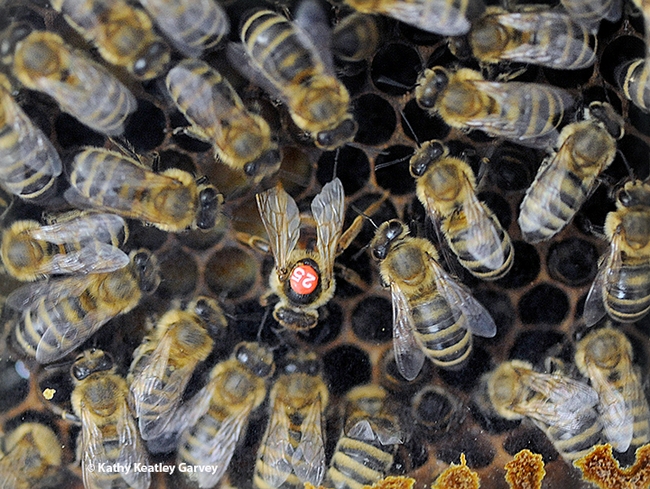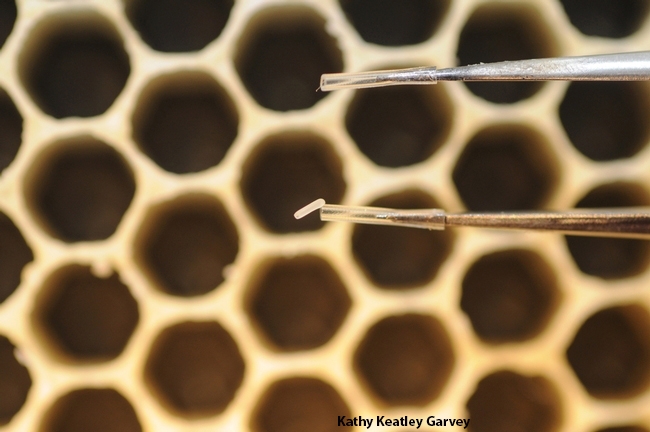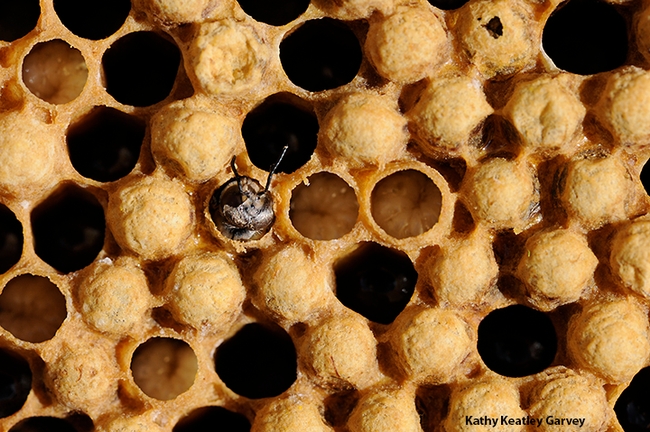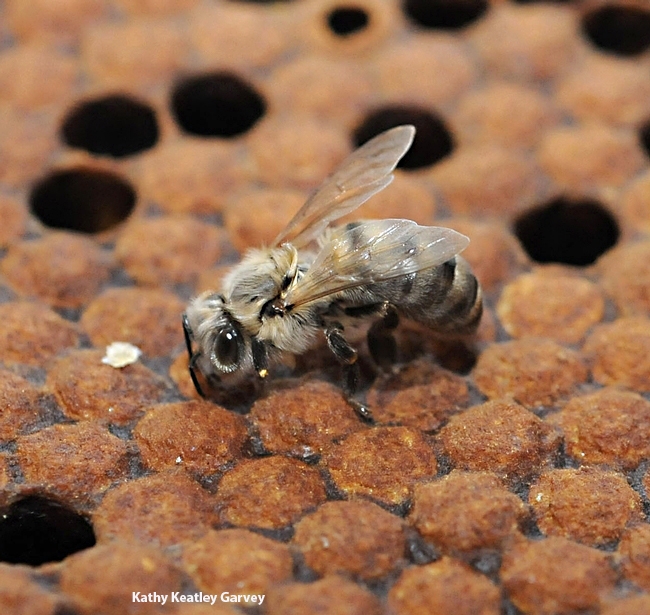- Author: Kathy Keatley Garvey
If you're struggling with triple-digit temperatures, think about the honey bees.
They need to collect water for their colony to cool the hive so their brood can develop. And for other purposes.
Just call them "The Water Girls."
Lately the bees have taken a liking to our birdbath. The birds? They're practicing social distancing.
We remember Extension apiculturist Eric Mussen (1946-2022) telling us "Like most other animals, the bodies of honey bees are mostly water. Thus, they need to drink water routinely as we do. Additionally, water (or sometimes nectar) is critical for diluting the gelatinous food secreted from the head glands of nurse bees, so that the queen, developing larvae, drones, and worker bees can swallow the food. They use water to keep the brood nest area at the proper relative humidity, especially when it gets hot and dry outside the hive. Water droplets, placed within the brood nest area, are evaporated by fanning worker bees and that cools (air conditions) the brood nest area to keep the eggs and developing brood at the critical 94 degrees Fahrenheit required for proper development."
Unlike us, honey bees cannot simply turn on a faucet. "They will fly up to nearly five miles to find a suitable watering source," Mussen told us back in 2014. "Suitable to honey bees might not be suitable to us, but if it is moist, it may be visited. Suitable to the neighbors is a separate question. Honey bees can become quite a nuisance if they visit drippy irrigation lines or hose connections, birdbaths, pet water dishes, swimming pools, fountains, or wet laundry and the like. The water foragers become habituated to those sites. If you try to dissuade the bees by drying up the source for a while, it becomes evident that the bees will visit the site every so often so they'll be around quickly after the water is returned."
What to do? "People have tried to use repellents in the water, but the bees are likely to use the odor as an attractant when attempting to relocate the water source. Some people have had success keeping bees and wasps out of their swimming pools with very lightweight oils or monomolecular films--their purpose is to prevent mosquitoes from being able to breathe. But, if the water is splashed very much, you'll require a new layer."
And all those bees struggling in your swimming pool? "Not all moribund honey bees in a swimming pool are there because they were trying to get a drink. Every day, approximately 1,000 old honey bees from each colony die naturally. This normally occurs during foraging, and the bees just flutter down to the ground, sidewalk, driveway, parking lot, or whatever they were passing over. Some flutter into swimming pools. They are not dead, yet, so they can and do inflict stings on people who bump into them on the surface of the water. "
Beekeepers should make sure there's a watering source on their property so the bees won't hunt for water elsewhere, Musssen pointed out. It should be available all year around. "Once the bees are habituated to the site, most of them will use that source."
It's also a good idea to place corks in a birdbath for the bees to stand on. Bees don't like to get their feet wet. And if they drop into the water structure, they can drown.
As for the bee tenants in our watering hole, bring 'em on.
We absolutely love "The Water Girls." The birds, well, not so much. (But they do have access to a second birdbath and a fish pond.)
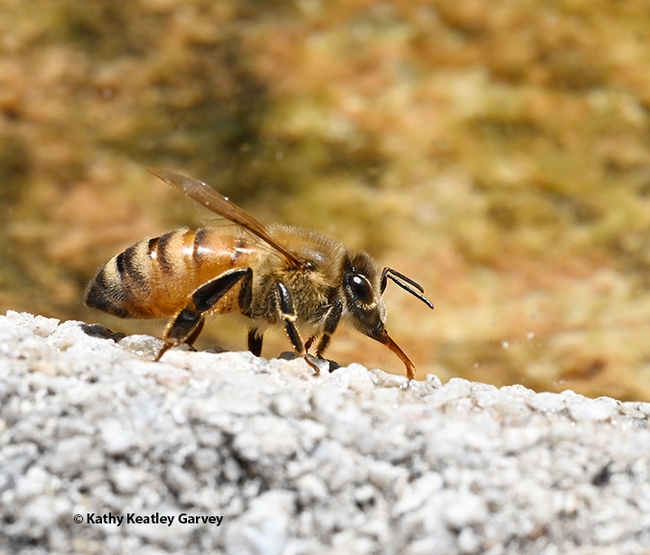
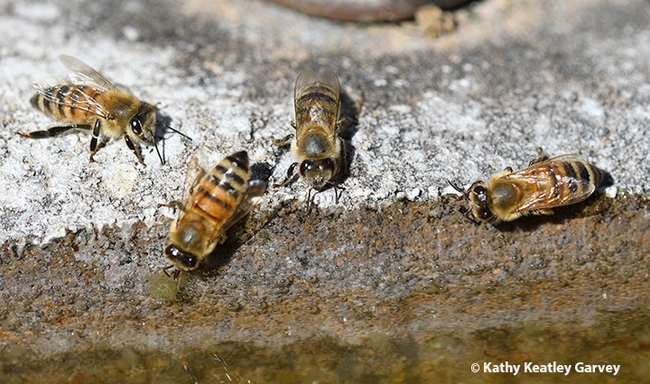
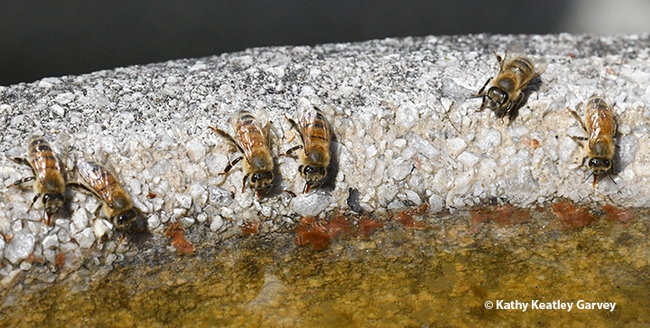
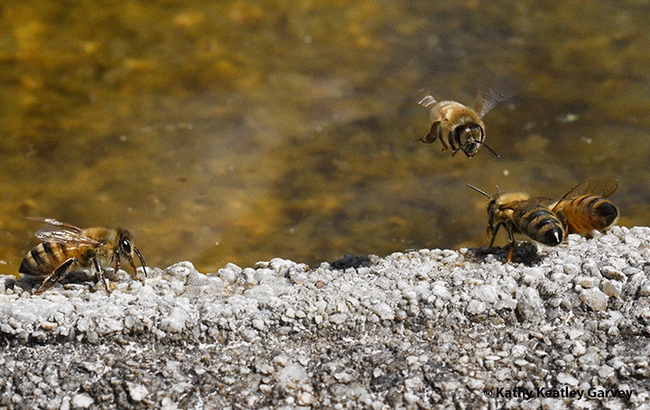
- Author: Kathy Keatley Garvey
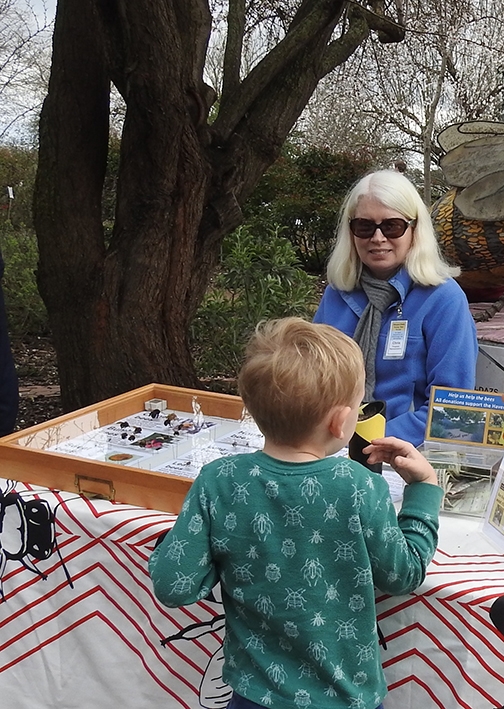
That's when the UC Davis Department of Entomology and Nematology will celebrate the 15th anniversary of its bee garden with an open house from 10 a.m. to noon. It's free and family friendly.
The half-acre garden is located next to the Harry H. Laidlaw Jr. Honey Research Facility on Bee Biology Road, west of the central campus.
The open house will include a tour of the garden at 11 a.m.; catch-and-release bee activity to observe bees up close; information about low-water plants; and presentations on University of California pollinator research.
Open from dawn to dusk (free admission), the Bee Haven is described as "a unique outdoor museum that provides resources for local bee pollinators, inspires and educates visitors to create pollinator habitat gardens, and provides a site for the observation and study of bees and the plants that support them."
Director of the garden is Elina Lastro Niño, associate professor of Cooperative Extension - Apiculture, UC Davis Department of Entomology and Nematology. Christine Casey is the manager, the academic program management officer.
The garden was installed in the fall of 2009, under the tenure of interim department chair Lynn Kimsey, now UC Davis distinguished professor emerita, and with primary funds from the Häagen-Dazs ice cream brand. Featuring a series of interconnected gardens with names like “Honeycomb Hideout,” “Nectar Nook” and “Pollinator Patch,” it was designed to provide the Laidlaw honey bees with a year-around food source, raise public awareness about the plight of honey bees, encourage visitors to plant bee-friendly gardens of their own, and serve as a research site.
“This garden is a living laboratory to educate, inspire and engage people of all ages in the serious work of helping to save honey bees,” said Dori Bailey, then director of Haagen-Dazs Consumer Communications.
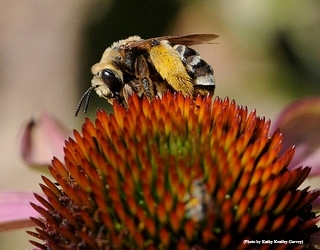
Art graces the garden, thanks to the UC Davis Art/Science Fusion Program, founded and directed by entomologist-artist Diane Ullman, UC Davis distinguished professor of entomology; and Davis-based artist Donna Billick. Billick, a self-described "rock artist," sculpted the six-foot-long worker bee that anchors the haven. Students and area residents crafted the bee-motif ceramic tiles that line a bench, which also includes the names of major donors.
A mural featuring native bees graces the shed in the garden. It was a project of the Entomology 1 class, "Art, Science and the World of Insects," taught by Ullman and Billick. Then doctoral student Sarah Dalrymple of the Rick Karban lab, served as the graphics project coordinator and teaching assistant, guiding the students on design, creation and installation of the panels. She went on to be named the 2011 recipient of the UC Davis Outstanding Graduate Student Teaching Award and praised for fusing the boundaries of biology, art and culture.
The Bee Haven came to "bee" after officials at the Haagen-Dazs read a research news story on honey bees, written by communication specialist Kathy Keatley Garvey and telephoned her. The article, on "building a better bee," chronicled the plight of honey bees and the work of bee breeder-geneticist Susan Cobey, then manager of the Harry H. Laidlaw Jr. Honey Bee Research Facility and now with Washington State University. Haagen-Dazs served as the primary donor of the garden and also funded the Häagen-Dazs Postdoctoral Fellowship at UC Davis. It went to Michelle Flenniken, an insect virus researcher based at UC San Francisco. She is now a professor at Montana State University.
Links:
Sausalito Team Wins Design Competition
http://ucanr.edu/blogs/blogcore/postdetail.cfm?postnum=15240
Grand Opening Celebration of Honey Bee Garden
http://ucanr.edu/blogs/blogcore/postdetail.cfm?postnum=15249
Eagle Scout Project: Fence Around the Bee Garden
http://ucanr.edu/blogs/blogcore/postdetail.cfm?postnum=10166
Campus Buzzway: Wildflowers
http://ucanr.edu/blogs/blogcore/postdetail.cfm?postnum=15242
Haagen-Dazs Honey Bee Haven: Sacramento Bee Award
(With photo of founding volunteers)
http://ucanr.edu/blogs/blogcore/postdetail.cfm?postnum=10205
Shedding Light on Native Bees
https://ucanr.edu/blogs/blogcore/postdetail.cfm?postnum=27570
For more information on the UC Davis Bee Haven, access the website at https://beegarden.ucdavis.edu.
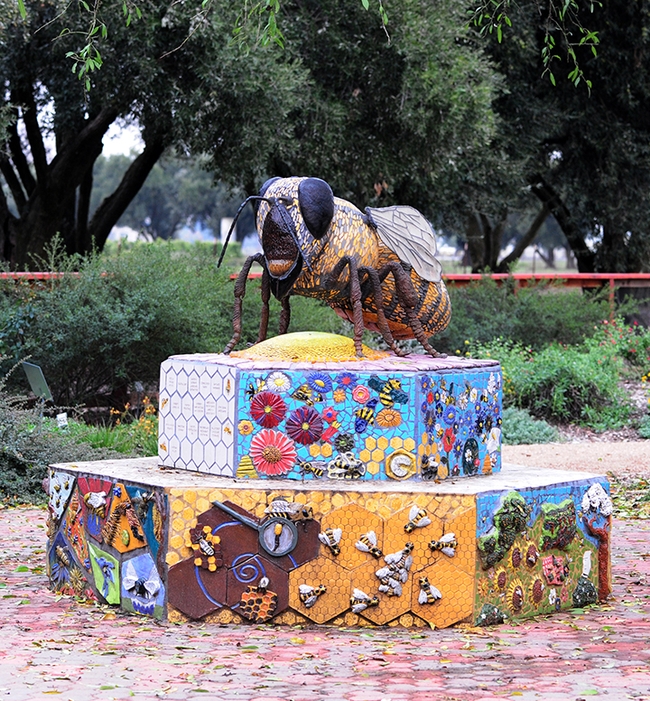
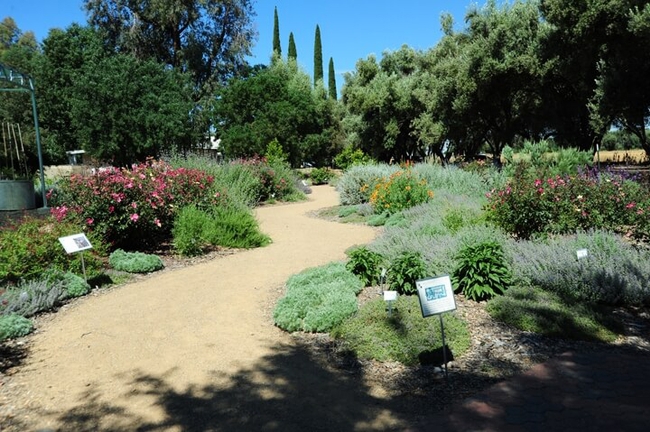
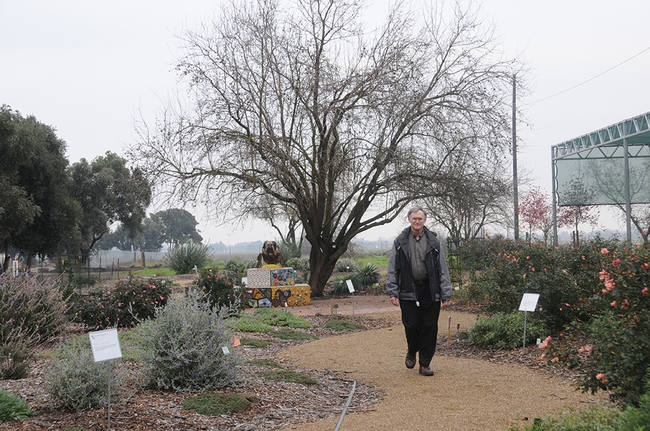
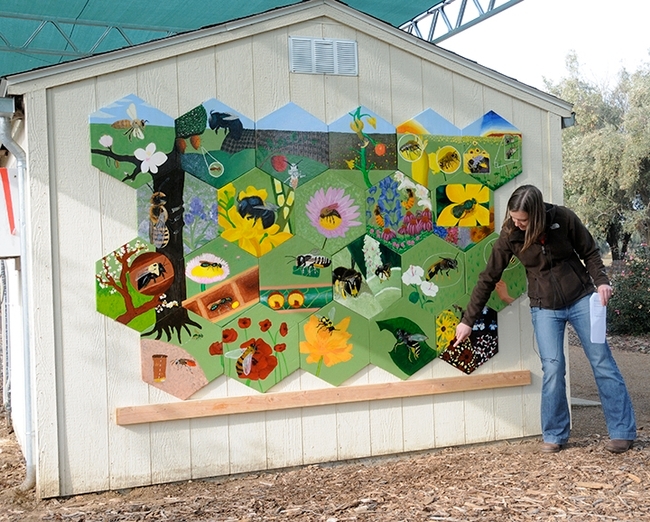
- Author: Kathy Keatley Garvey
It's bee-ginning to look a lot like Christmas...
All hail our littlest agricultural worker.
European colonists brought the honey bee (Apis mellifera) to what is now the United States in 1622. Specifically, the bees arrived at the Jamestown colony (Virginia). Native Americans nicknamed the honey bee "the white man's fly."
California would have to wait until 1853 for honey bees to arrive. That's when Texas beekeeper Christopher Shelton, brought his colonies to the San Jose area. A plaque outside the international terminal of the San Jose airport documents their arrival.
The plaque, "First Honeybees in California," reads:
"Here, on the 1939-acre Rancho Potrero de Santa Clara, Christopher A. Shelton in early March 1853 introduced the honey bee to California. In Aspinwall, Panama, Shelton purchased 12 bee hives from a New Yorker and transported them by rail, “bongo,” pack mule and steamship to San Francisco. Only enough bees survived to fill one hive, but these quickly propagated, laying the foundation for California's modern beekeeping industry. California registered Landmark No. 945 plaque placed by the State Department of Parks and Recreation in Cooperation with E. Clampus Vitus, Mountain Charlie Chapter No. 1850, and in honor of San Jose City Historian Clyde Arbuckle, March 6, 1982."
According to atlasobscura.com, "In 1853, Texan Christopher A. Shelton purchased 12 hives of bees from an unknown beekeeper in what is now Colon, Panama. The bees, already transported to Panama from New York, were then sent up to San Francisco and Alviso, the nearest port to San Jose, by steamer. They then continued their journey via train and mule to the 1939-acre Rancho Potrero de Santa Clara where Shelton settled."
"Only enough bees to form one hive survived," the Atlas Obscura post related. "These German black bees (Apis mellifera mellifera) endured the tedious trek and were propagated throughout California and soon the whole of the West Coast. Shelton was not so fortunate and died alongside other prominent South Bay Residents of the time on the infamous Jenny Lind steamship explosion just a month after the receipt of his bees. His three hives—it didn't take long for his original stock to multiply—were sold at auction for $110 each, 22 times the price of a beehive on the East Coast."
Ever seen the inside of a hive? That's where the magic begins. You'll see "The Girls": the queen, nurse maids, nannies, royal attendants, builders, architects, dancers, honey tenders, pollen packers, propolis or "glue" specialists, air conditioning and heating technicians, guards, and undertakers.
And in spring, summer and early fall, you'll see "The Boys," the drones. They have one responsibility: reproduction. The drone mates in mid-air with a virgin queen, and then he dies--"and with a smile on his face," according to the UC Cooperative Extension apiculturist Eric Mussen (1944-2022).
As we celebrate Merry Christmas and the New Year, the bees could use some cele-bee-tion, too.
Merry Christmas and Happy New Year from the Bug Squad.
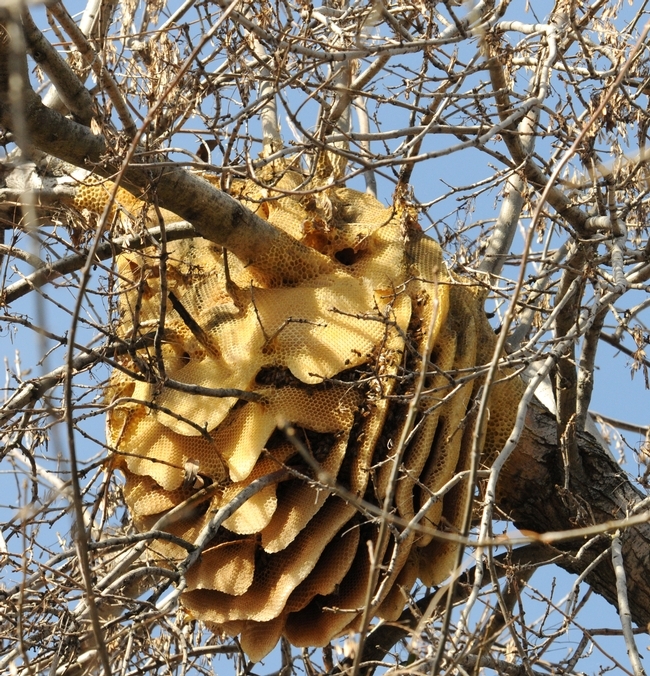
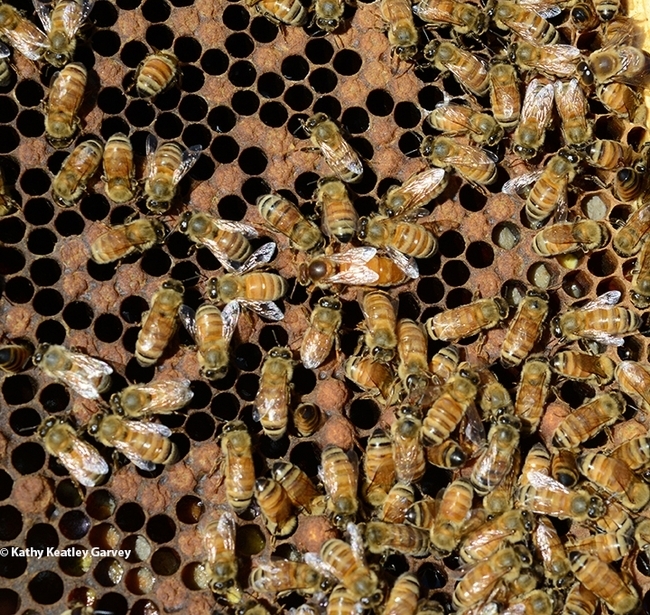
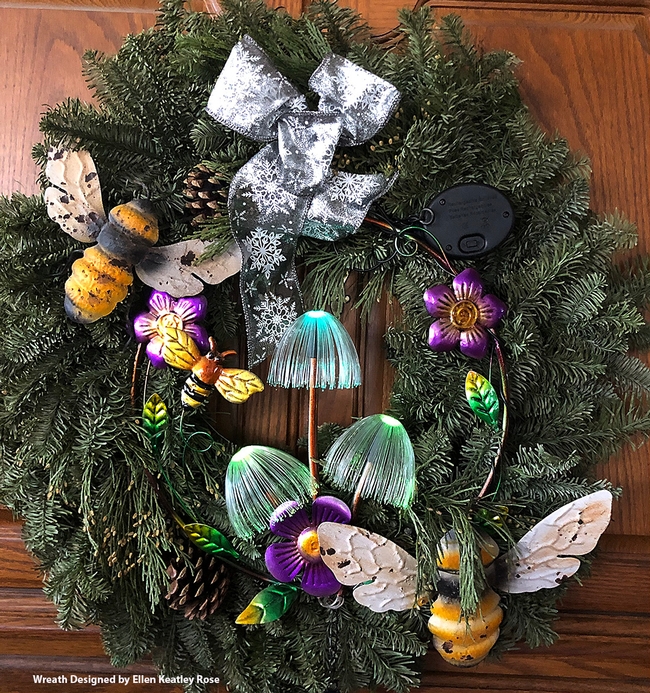
- Author: Kathy Keatley Garvey

Zero. Zilch. Nada.
Just a partridge in a pear tree, 2 turtle doves, 3 French hens, 4 calling birds, 5 gold rings, 6 geese-a-laying, 7 swans-a-swimming, 8 maids a'milking, 9 ladies dancing, 10 lords-a-leaping, and 11 pipers piping.
Where, oh, where, are all the insects?
So we replaced "five gold rings" with "five golden bees." Other insects crawled, hopped, leaped and fluttered into the song. We sang the piece during our 2010 UC Davis Department of Entomology and Nematology holiday party. The lyrics went viral when U.S. News picked it up:
On the first day of Christmas, my true love gave to me, a psyllid in a pear tree.
On the second day of Christmas, my true love gave to me, 2 tortoises beetles and a psyllid in a pear tree
On the third day of Christmas, my true love gave to me, 3 French flies, 2 tortoise beetles and a psyllid in a pear tree
On the fourth day of Christmas, my true love gave to me, 4 calling cicadas, 3 French flies, 2 tortoise beetles and a psyllid in a pear tree
On the fifth day of Christmas, my true love gave to me 5 golden bees, 4 calling cicadas, 3 French flies, 2 tortoise beetles and a psyllid in a pear tree
On the sixth day of Christmas, my true love gave to me 6 lice a'laying, 5 golden bees, 4 calling cicadas, 3 French flies, 2 tortoise beetles and a psyllid in a pear tree
On the seventh day of Christmas, my true love gave to me 7 boatmen swimming, 6 lice a'laying, 5 golden bees, 4 calling cicadas, 3 French flies, 2 tortoise beetles and a psyllid in a pear tree
On the eighth day of Christmas, my true love gave to me 8 ants a'milking aphids, 7 boatmen swimming, 6 lice a'laying, 5 golden bees, 4 calling cicadas, 3 French flies, 2 tortoise beetles and a psyllid in a pear tree
On the ninth day of Christmas, my true love gave to me 9 mayflies dancing, 8 ants a'milking aphids, 7 boatmen swimming, 6 lice a'laying, 5 golden bees, 4 calling cicadas, 3 French flies, 2 tortoise beetles and a psyllid in a pear tree
On the tenth day of Christmas, my true love gave to me 10 locusts leaping, 9 mayflies dancing, 8 ants a'milking aphids, 7 boatmen swimming, 6 lice a'laying, 5 golden bees, 4 calling cicadas, 3 French flies, 2 tortoise beetles and a psyllid in a pear tree
On the 11th day of Christmas, my true love gave to me 11 queen bees piping, 10 locusts leaping, 9 mayflies dancing, 8 ants a'milking aphids, 7 boatmen swimming, 6 lice a'laying, 5 golden bees, 4 calling cicadas, 3 French flies, 2 tortoise beetles and a psyllid in a pear tree
On the 12th day of Christmas, my true love gave to me 12 deathwatch beetles drumming, 11 queen bees piping, 10 locusts leaping, 9 mayflies dancing, 8 ants a'milking aphids, 7 boatmen swimming, 6 lice a'laying, 5 golden bees, 4 calling cicadas, 3 French flies, 2 tortoise beetles and a psyllid in a pear tree
"On the 13th day of Christmas, Californians woke to see: 13 Kaphra beetles, ?12 Diaprepes weevils, ?11 citrus psyllids, ?10 Tropilaelaps clareae, ?9 melon fruit flies, 8 Aedes aegypti, 7 ash tree borers, 6 six spotted-wing Drosophila, 5 ?five gypsy moths, 4 Japanese beetles, 3 imported fire ants, 2 brown apple moths, and a medfly in a pear tree."
Today the song is still making the rounds, but with some different pests--pests that challenge entomologists in the California Department of Food and Agriculture:
On the first day of Christmas, my true love gave to me, a psyllid in a pear tree.
One the second day of Christmas, my true love gave to me, two peach fruit flies
On the third day of Christmas, my true love gave to me, three false codling moths
On the fourth day of Christmas, my true love gave to me, four peach fruit flies
On the fifth day of Christmas, my true love gave to me, five gypsy moths
On the sixth day of Christmas, my true love gave to me, six white striped fruit flies
On the seventh day of Christmas, my true love gave to me, seven imported fire ants
On the eighth day of Christmas, my true love gave to me, eight longhorn beetles
On the ninth day of Christmas, my true love gave to me, nine melon fruit flies
On the 10th day of Christmas, my true love gave to me, ten brown apple moths
On the 11th day of Christmas, my true love gave to me, eleven citrus psyllids
On the 12th day of Christmas, my true love gave to me, twelve guava fruit flies.
On the 13th day of Christmas, my true love gave to me, thirteen Japanese beetles
And, then, of course, there's that dratted pest, the Varroa destructor (varroa mite) from Asia, which arrived in the United States in 1987. Known as the No. 1 enemy of beekeepers, this external parasitic mite feeds on fat body tissue, and can transmit debilitating viruses. This is not what you want for Christmas--or any other time.
'Tis the season to celebrate the holidays...and to check your Yule tree branches for a praying mantis egg case (ootheca).
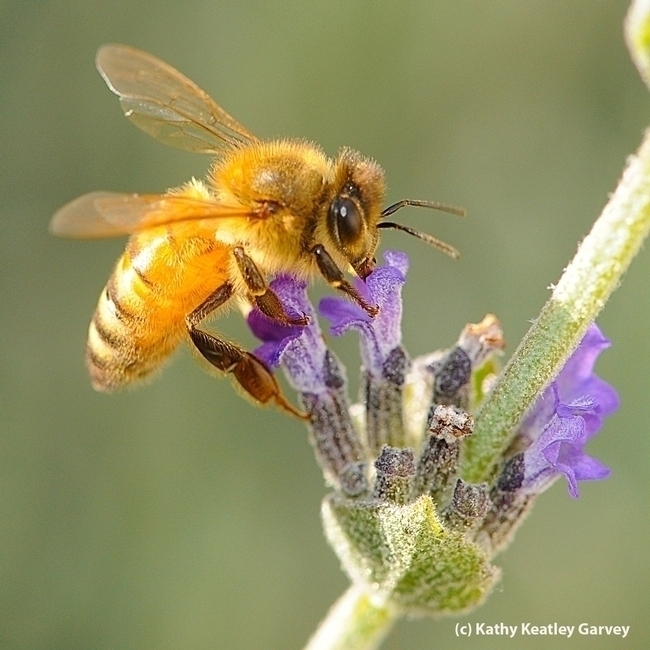
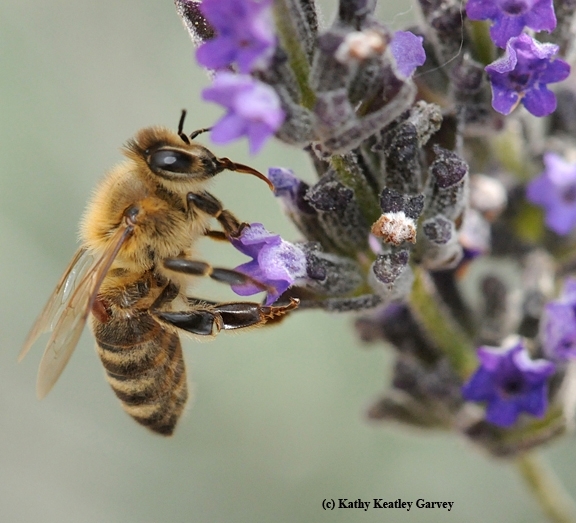
- Author: Kathy Keatley Garvey
It's a week before Christmas and it's not just the geese that are getting fat.
If you're thinking that the bathroom scale and you are not good friends, not to worry.
We remember the late Extension apiculturist emeritus Eric Mussen (1944-2022) of the UC Davis Department of Entomology, emphasizing the massive weight gain that occurs during the larval stage of the honey bee. He used to speak at scores of beekeeping functions throughout the year, and every time he talked about larval weight gain, he always drew a "Wow!" or "Incredible!" or "Amazing!"
"A honey bee egg weighs about 0.1 mg," Mussen told us. "The first stage larva weighs the same. Over the next six days of larval life the larva goes from 0.1 mg to around 120 mg. It defecates once, just before pupating, and the resulting adult bee weighs around 110 mg. Thus, the new bee weighs about 1,000 times the weight of the one-day-old larva."
Now get this:
"If a human baby, weighing eight pounds at birth, were to grow at the same rate, the baby would weigh 8,000 pounds, or 4 tons, at the end of six days."
Four tons in six days? Fortunately, what goes on with Apis mellifera does not apply to Homo sapiens.
